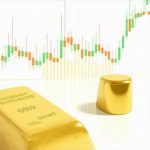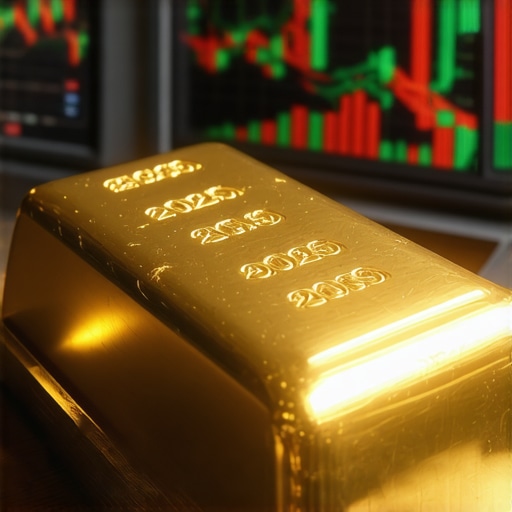Decoding the Gold Market: Why 2025 Is a Pivotal Year for Investors
As global economies navigate through ongoing uncertainties, the gold market emerges as a beacon of stability and opportunity. Understanding the intricate trends shaping gold prices in 2025 requires a deep dive into economic indicators, geopolitical influences, and technological advancements that collectively orchestrate the metal’s value. Investors and analysts alike are keen to unravel these dynamics, aiming to forecast price movements with greater precision and strategic foresight.
Geopolitical Tensions and Their Ripple Effects on Gold Valuation
In 2025, geopolitical unrest remains a significant catalyst driving gold prices upward. Conflicts and diplomatic strains, especially in resource-rich regions, have historically triggered safe-haven buying. For example, recent escalations in trade disputes and regional conflicts have led to surges in gold demand as investors seek to hedge against market volatility. This pattern underscores gold’s enduring role as a protective asset amid global uncertainties.
Technological Innovations: Transforming Gold Mining and Supply Dynamics
Advancements in mining technology are reshaping gold supply chains, influencing market availability and pricing. Enhanced extraction techniques and automation not only reduce production costs but also improve yield efficiency. However, these developments are balanced by environmental regulations and resource depletion concerns, which may constrain supply growth. Such complexities create a nuanced landscape where technological progress intersects with sustainability challenges.
How Do Central Bank Policies Influence Gold Prices in 2025?
Central banks continue to be pivotal players in the gold market through their reserve management strategies. In 2025, shifts in monetary policies, including interest rate adjustments and quantitative easing measures, directly impact gold’s appeal as an investment. For instance, lower real interest rates typically increase gold’s attractiveness by reducing opportunity costs. Moreover, ongoing gold purchases by central banks, particularly in emerging economies, signal confidence in gold as a reserve asset and contribute to upward price pressure. Analyzing these policy moves offers critical insight into potential price trajectories.
Inflationary Pressures and the Renewed Allure of Gold as an Inflation Hedge
Rising inflation rates in various economies have reignited interest in gold’s traditional role as a safeguard against purchasing power erosion. Investors are increasingly turning to gold to diversify portfolios and preserve wealth amidst volatile inflationary environments. Strategic gold investment methods, such as through physical bullion, ETFs, or mining stocks, are gaining traction. For practical guidance on leveraging gold stocks within defensive portfolios, readers can explore how gold stocks can boost defensive portfolios in 2025.
Environmental, Social, and Governance (ESG) Trends Reshape Gold Investment Strategies
The rising importance of ESG criteria influences both gold production and investment. Mining companies adopting sustainable practices are becoming more attractive to conscientious investors. This shift impacts market valuations and encourages transparency across the supply chain. Understanding ESG’s role enriches the analysis of gold market trends and highlights emerging opportunities aligned with ethical investing.
For those intrigued by the intersection of demand trends and price movements, this detailed exploration of global gold demand trends offers valuable perspectives.
Curious to share your thoughts or experiences with gold investing in 2025? Join the discussion below and connect with a community of informed investors navigating this dynamic market.
Authoritative insights from the World Gold Council, a premier source for comprehensive gold market data and analysis, further substantiate these observations. Their latest reports on gold demand and market trends remain essential reading for a nuanced understanding.
Central Bank Gold Reserves: Strategic Moves and Market Impact
Central banks are increasingly assertive in managing gold reserves in 2025, reflecting strategic hedging against currency volatility and geopolitical risks. Their accumulation patterns provide critical signals to investors about the metal’s future demand trajectory. Notably, emerging market central banks, particularly in Asia and the Middle East, have accelerated gold purchases as part of diversification efforts away from traditional reserve currencies. This trend not only tightens supply but also reinforces gold’s status as a global monetary asset.
Moreover, the policies of major central banks such as the Federal Reserve and the European Central Bank significantly influence gold prices through interest rate decisions and inflation targeting. When real interest rates fall or remain negative, gold tends to outperform, as it carries no yield but benefits from lower opportunity costs. Investors monitoring these macroeconomic indicators can better time their gold acquisitions and portfolio adjustments.
What Role Will ESG Standards Play in Shaping Gold Investment Portfolios?
Environmental, Social, and Governance (ESG) criteria have become pivotal in investment decision-making, reshaping how gold mining companies operate and how investors allocate capital. Mining firms that prioritize sustainable practices, community engagement, and ethical labor standards attract premium valuations and long-term investor confidence. This shift is compelling asset managers to integrate ESG metrics when selecting gold-related equities and funds.
Investors looking to capitalize on this trend may consider ESG-focused gold ETFs or mutual funds, which screen for companies with robust sustainability profiles. This approach not only aligns with ethical investing goals but also mitigates risks associated with regulatory penalties, social opposition, and environmental liabilities.
For detailed strategies on leveraging gold mutual funds within sustainable portfolios, readers can explore why investing in gold mutual funds is smart in 2025 and beyond.
Volatility Management: Using Gold to Navigate Market Uncertainty
In times of heightened market volatility, gold serves as a critical hedge, offering portfolio diversification and risk mitigation. The metal’s negative correlation with equities during crises underscores its defensive qualities. Strategic allocation to gold-based assets helps investors cushion against abrupt market downturns and currency fluctuations.
Leveraging gold futures and ETFs provides liquidity and flexibility, allowing active traders and long-term investors to adjust positions in response to evolving market conditions. However, successful navigation requires an understanding of gold futures market patterns and disciplined trading strategies.
For investors aiming to master these techniques, mastering gold trading techniques: advanced tips for success offers comprehensive guidance on maximizing profits while managing risks.
Integrating Gold into Diversified Portfolios: Practical Insights
Optimal portfolio construction increasingly incorporates gold to balance growth and safety. Strategic allocation typically ranges between 5% to 15%, depending on an investor’s risk tolerance and market outlook. Both physical gold and gold equities contribute distinct advantages: physical gold offers tangible security and inflation protection, while gold stocks provide growth potential and dividend income.
Investors must also consider tax implications, storage costs, and liquidity preferences when choosing between gold investment vehicles. A blended approach, combining bullion, ETFs, and mining stocks, often yields the best balance between stability and returns.
To explore detailed portfolio strategies that effectively balance gold and stocks in 2025, readers can visit gold vs stocks: effective portfolio balance strategies 2025.
Engage with us: How are you adjusting your gold investment strategy in response to 2025’s market dynamics? Share your insights or questions below to enrich our community’s expertise.
For authoritative perspectives and comprehensive data on gold market trends, the World Gold Council remains a trusted resource. Their latest insights can be accessed at World Gold Council: Gold Demand Trends 2025.
Decoding Market Sentiment: The Psychological Drivers Behind Gold Demand Surges
Beyond tangible economic indicators, investor psychology plays a crucial role in gold price dynamics. In 2025, behavioral finance principles help explain sudden surges in gold buying amid ambiguous market signals. Fear, uncertainty, and herd behavior amplify gold’s appeal as a safe haven. Sophisticated investors leverage sentiment analysis tools, including social media trends and news sentiment indices, to anticipate shifts in gold demand ahead of market movements. This nuanced approach allows for preemptive portfolio adjustments, mitigating downside risks while capitalizing on gold’s volatility.
Integrating Quantitative Models for Predictive Gold Pricing: A Technical Perspective
Cutting-edge quantitative models incorporating machine learning and big data analytics are revolutionizing gold price forecasting. These models analyze vast datasets spanning macroeconomic variables, geopolitical events, and historical price patterns to generate probabilistic price trajectories. Unlike traditional linear models, advanced algorithms capture nonlinear dependencies and regime shifts, enhancing prediction accuracy. Portfolio managers increasingly rely on these insights to optimize gold allocations dynamically, balancing risk exposure with expected returns.
How Can Investors Leverage Machine Learning to Forecast Gold Price Movements Effectively?
Machine learning algorithms, such as random forests and neural networks, enable investors to identify complex patterns that precede gold price fluctuations. By training models on historical data including inflation rates, central bank interventions, and global conflict indices, investors can generate real-time signals for entry and exit points. However, model robustness depends on continuous data validation and avoidance of overfitting. Combining machine learning outputs with expert judgment and macroeconomic analysis creates a comprehensive framework for informed decision-making.
Leading research from the National Bureau of Economic Research (NBER) underscores the efficacy of hybrid quantitative-qualitative approaches in commodity forecasting, emphasizing gold’s unique market drivers.
Tax Efficiency and Regulatory Nuances in Gold Investment: Navigating Complex Jurisdictions
Investors in 2025 must navigate increasingly complex tax regimes affecting gold investments across jurisdictions. Capital gains tax rates, stamp duties on bullion transactions, and reporting requirements vary widely and impact net returns. Strategic structuring of gold holdings—through trusts, offshore accounts, or tax-advantaged funds—can optimize after-tax performance. Moreover, evolving regulations addressing anti-money laundering (AML) and know-your-customer (KYC) protocols necessitate compliance diligence to avoid penalties and ensure transactional transparency.
Investment advisors recommend proactive consultation with international tax experts to tailor gold investment strategies that align with both fiscal efficiency and regulatory compliance.
Advanced Hedging Techniques: Combining Gold with Derivatives to Mitigate Portfolio Risk
Gold’s role as a hedge is enhanced when combined with derivatives such as options and futures, enabling sophisticated risk management strategies. Protective puts on gold ETFs can cap downside risk while maintaining upside potential, while futures contracts allow for precise exposure adjustments amid changing market conditions. Cross-asset hedging strategies, integrating gold with currency and equity derivatives, further diversify risk sources. However, these strategies demand advanced expertise due to margin requirements, liquidity considerations, and the potential for leverage-induced volatility.
For practitioners seeking to deepen their tactical toolkit, CME Group’s educational resources on gold futures and options provide comprehensive insights into derivative applications.
Emerging Market Demand: Assessing the Impact of Asia-Pacific Consumer Trends on Gold Prices
The Asia-Pacific region continues to be a dominant force in global gold demand, driven by cultural affinity, rising wealth, and evolving investment preferences. In 2025, millennial and Gen Z consumers in key markets such as India and China are showing increased interest in gold-backed digital assets and ethically sourced gold products. This demographic shift is prompting the industry to innovate in product offerings and marketing approaches. Additionally, urbanization and financial inclusion initiatives are expanding retail gold ownership, reinforcing sustained demand growth despite global economic headwinds.
Understanding these regional consumer dynamics is critical for investors aiming to anticipate demand-driven price pressures and identify emerging opportunities within gold supply chains.
Engage with us: How are you integrating advanced analytical tools and regional demand insights into your 2025 gold investment strategy? Share your perspectives below to contribute to a collaborative knowledge base of market expertise.
Behavioral Analytics Meets Artificial Intelligence: Elevating Gold Market Predictions
In the evolving landscape of gold investment, integrating behavioral analytics with artificial intelligence (AI) technologies is pioneering new frontiers for market prediction. Investors are increasingly leveraging sentiment data extracted from social media, news outlets, and economic reports to feed AI algorithms that identify subtle shifts in investor mood and market psychology. This fusion enables anticipatory strategies that preempt traditional price movements, offering a competitive edge in timing acquisitions and divestitures within gold markets.
Decoding Complex Market Interactions: Multi-Factor Quantitative Frameworks
Advanced quantitative frameworks now synthesize macroeconomic indicators, geopolitical risk indices, and ESG compliance metrics to forecast gold price dynamics more comprehensively. These models utilize ensemble machine learning techniques to weigh diverse influences, capturing the interplay between supply constraints, policy shifts, and consumer behavior. For instance, integrating carbon footprint data of mining companies into valuation models reflects the growing investor emphasis on sustainability without sacrificing financial rigor.
What Are the Most Effective Machine Learning Techniques for Gold Price Forecasting in Volatile Markets?
Among the arsenal of machine learning tools, recurrent neural networks (RNNs) and long short-term memory (LSTM) models excel in handling sequential time-series data characteristic of gold pricing. These architectures adeptly model temporal dependencies and regime changes, outperforming simpler algorithms like random forests in scenarios of abrupt market volatility. Furthermore, hybrid models combining LSTM with attention mechanisms enable nuanced focus on critical events such as central bank announcements or geopolitical developments, enhancing predictive accuracy.
Recent empirical research from the National Bureau of Economic Research (NBER) corroborates the superiority of these approaches in commodity price forecasting, emphasizing their adaptability to the idiosyncrasies of the gold market.
Leveraging Blockchain for Transparency and Authenticity in Gold Supply Chains
Blockchain technology is revolutionizing traceability within gold supply chains, addressing persistent challenges related to provenance verification and ethical sourcing. By implementing immutable ledgers and smart contracts, stakeholders can authenticate the origin of gold bars and coins, ensuring compliance with ESG standards and reducing risks of conflict minerals entering the market. This transparency not only enhances investor confidence but also supports premium pricing for responsibly sourced gold.

Strategic Implications of Regulatory Evolution on Gold Derivatives Trading
Regulatory bodies worldwide are intensifying scrutiny over gold derivatives markets to mitigate systemic risks and enhance market integrity. New frameworks impose stricter margin requirements, position limits, and reporting standards, impacting liquidity and trading strategies. Sophisticated investors must navigate these evolving regulations with agility, employing algorithmic compliance tools and adaptive risk management protocols to sustain profitability while adhering to legal mandates.
For comprehensive regulatory insights, the CME Group’s educational resources offer invaluable guidance tailored to professional traders.
Engage with the Frontier of Gold Investment Strategy
As the gold market in 2025 becomes increasingly complex, blending AI-driven analytics, ESG considerations, and regulatory awareness is indispensable for sophisticated investors. Are you ready to elevate your gold investment approach with these cutting-edge methodologies? Join our expert forum below to discuss implementation strategies, share insights, and collaborate with industry leaders navigating this dynamic environment.
Frequently Asked Questions (FAQ)
Why is gold considered a safe-haven asset during geopolitical tensions?
Gold’s intrinsic value, limited supply, and universal acceptance make it a preferred refuge during geopolitical unrest. Investors flock to gold to preserve wealth when traditional markets experience volatility or uncertainty, as gold historically retains value even amid crises.
How do central bank policies impact gold prices in 2025?
Central banks influence gold prices through reserve accumulation and monetary policy actions. Lower real interest rates reduce the opportunity cost of holding non-yielding gold, increasing its appeal. Additionally, aggressive gold purchases by emerging market central banks tighten supply and signal confidence, driving prices upward.
What role does ESG investing play in the gold market?
ESG criteria are reshaping gold investment by prioritizing sustainable mining practices, ethical labor standards, and environmental stewardship. Investors increasingly prefer gold assets with strong ESG profiles, which can command premium valuations and reduce regulatory and reputational risks.
Can machine learning reliably forecast gold price movements?
Machine learning models, especially advanced architectures like LSTM and RNNs, excel at capturing complex, nonlinear patterns and temporal dependencies in gold price data. When combined with expert macroeconomic and geopolitical analysis, these models enhance forecast accuracy but require continuous validation to avoid overfitting.
How does blockchain technology improve transparency in gold supply chains?
Blockchain enables immutable record-keeping of gold provenance and transactions, ensuring authenticity and ethical sourcing. This transparency helps prevent conflict minerals from entering the market and aligns with ESG compliance, thereby boosting investor trust and potentially supporting higher valuations.
What are the tax considerations for gold investors in different jurisdictions?
Tax regimes vary widely, including capital gains taxes, stamp duties, and reporting requirements. Investors should seek tailored advice on structuring holdings—such as through trusts or tax-advantaged funds—to optimize after-tax returns while ensuring compliance with AML and KYC regulations.
How can derivatives be used to hedge gold investment risks?
Options and futures on gold allow investors to manage downside risk and adjust exposure dynamically. Protective puts can cap losses while maintaining upside potential, and futures contracts enable precise positioning. However, these instruments require advanced knowledge due to margin, liquidity, and leverage complexities.
What impact is Asia-Pacific consumer demand having on the gold market?
Asia-Pacific remains the largest driver of global gold demand, fueled by cultural affinity, rising wealth, and younger generations adopting digital and ethically sourced gold products. This sustained demand growth shapes price dynamics and prompts innovation in product offerings.
How does investor psychology influence gold price volatility?
Sentiment factors such as fear, uncertainty, and herd behavior can trigger rapid surges or declines in gold demand. Behavioral analytics combined with AI-powered sentiment analysis provide early signals of market mood shifts, enabling proactive investment decisions.
What portfolio allocation to gold is recommended for 2025?
Optimal allocations typically range from 5% to 15%, balancing growth and protection based on risk tolerance. A diversified approach incorporating physical bullion, ETFs, and mining stocks can maximize benefits while addressing liquidity and tax considerations.
Trusted External Sources
- World Gold Council: The leading authority on gold market data, providing comprehensive research on demand trends, supply dynamics, and investment strategies essential for informed decision-making.
- National Bureau of Economic Research (NBER): Offers seminal academic papers and empirical studies on commodity price forecasting and the application of machine learning models in gold market analysis.
- CME Group: Provides in-depth educational resources on gold futures and options trading, crucial for understanding derivative-based hedging and risk management techniques.
- International Finance Corporation (IFC): Supplies insights into ESG standards and sustainable mining practices, highlighting the intersection of ethical investing and gold production.
- Asian Development Bank (ADB): Delivers valuable data on Asia-Pacific consumer trends, urbanization, and financial inclusion impacting gold demand in emerging markets.
Conclusion
As 2025 unfolds, the gold market remains a multifaceted arena shaped by geopolitical tensions, central bank maneuvers, technological innovation, and evolving investor preferences. Understanding the interplay between macroeconomic forces, ESG imperatives, and cutting-edge analytical tools is essential for navigating price fluctuations and capitalizing on emerging opportunities. Leveraging advanced forecasting models, embracing sustainable investment criteria, and integrating gold strategically within diversified portfolios empower investors to mitigate risk and enhance returns. Embrace this expertise to refine your gold investment strategy and join the ongoing dialogue within a community of informed market participants. Share your experiences, explore related expert analyses, and stay ahead in this dynamic gold landscape.











This comprehensive overview of the 2025 gold market really highlights how intertwined geopolitical, technological, and macroeconomic factors are in influencing prices. I’ve been particularly interested in how advances in mining technology might not only affect supply but also open up new ethically sourced gold channels, which could resonate well with ESG-focused investors. Additionally, the role of central banks, especially in emerging economies, seems crucial in shaping demand; their strategic purchases might be signaling confidence in gold’s stability amid uncertain fiat currencies. From my experience, keeping an eye on regional demand, particularly in Asia-Pacific, offers valuable insights into future price movements—markets there are incredibly dynamic. I wonder, though, how investors can best balance physical gold holdings with these new digital and ESG-compatible options to optimize both security and ethical considerations? It seems a nuanced approach is necessary for 2025, given the pace of innovation and shifting regulations. Would love to hear others’ thoughts on integrating these various elements into a cohesive investment strategy.